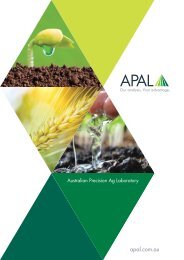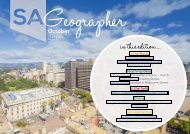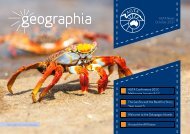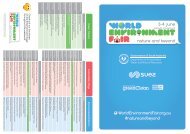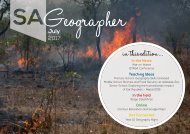Geographia AGTA News October 2017_ƒ3
Create successful ePaper yourself
Turn your PDF publications into a flip-book with our unique Google optimized e-Paper software.
<strong>AGTA</strong> <strong>News</strong><br />
<strong>October</strong> <strong>2017</strong><br />
<strong>AGTA</strong> Conference <strong>2017</strong>,<br />
Melbourne January 9-12<br />
The GeoSix and the Bushfire Story<br />
Year Level: 5<br />
Welcome to the Galapagos Islands<br />
Sally Lightfoot Crab, Galapagos<br />
Around the Affiliates
<strong>AGTA</strong> <strong>Geographia</strong> 2016/<strong>2017</strong><br />
Welcome to the latest edition of <strong>Geographia</strong>, the national newsletter of the<br />
Australian Geography Teachers’ Association.<br />
For further information about <strong>AGTA</strong> you can visit our website.<br />
<strong>AGTA</strong> Membership<br />
<strong>AGTA</strong> Membership.<br />
<strong>AGTA</strong> Conference<br />
The Australian Geography<br />
Teachers Association (<strong>AGTA</strong>)<br />
has seven members being<br />
the geography professional<br />
associations in each State and<br />
Northern Territory.<br />
Individuals, schools and other<br />
institutions, non-government<br />
organisations and businesses<br />
should join the relevant<br />
member association in each<br />
State or Territory (NT).<br />
<strong>AGTA</strong>’s 15 directors consist<br />
of two directors from each<br />
member affiliate, one being<br />
the President of the Affiliate<br />
Association and the other<br />
being nominated by the<br />
member.<br />
Individuals can only make<br />
representation to <strong>AGTA</strong><br />
through their association to<br />
bring issues to the national<br />
attention.<br />
<strong>AGTA</strong> exists as a national body<br />
representing the interests of<br />
Geography Teachers across<br />
Australia.<br />
If you have an issue that you<br />
believe would merit national<br />
attention you can raise it<br />
through your local state<br />
Geography Association.<br />
You can inquire about<br />
membership and connect with<br />
your local associations.<br />
New South Wales<br />
Northern Territory<br />
Queensland<br />
South Australia<br />
Tasmania<br />
Victoria<br />
Western Australia<br />
2019 <strong>AGTA</strong> Conference<br />
Geography Skills Unlocked<br />
Textbook<br />
The GeoSix and the<br />
Bushfire Story<br />
Year level: 5<br />
New resources for<br />
teachers: Hunger in<br />
a world of plenty<br />
Affiliate Contribution<br />
Around the affiliates<br />
GTANSW<br />
GHTANT<br />
GTAQ<br />
GTASA<br />
TGTA<br />
GTAV<br />
GTWA
<strong>AGTA</strong> Conference <strong>2017</strong>, Melbourne January 9-12<br />
The <strong>2017</strong> biennial Australian<br />
Geography Teachers<br />
Association Conference<br />
was hosted by GTAV at the<br />
University of Melbourne<br />
January 9-12. The first <strong>AGTA</strong><br />
conference was held in Sydney<br />
in 1968 and since then <strong>AGTA</strong><br />
conferences have been held<br />
throughout Australia with the<br />
2015 conference venturing<br />
offshore to Rotorua, New<br />
Zealand. The GTAV last hosted<br />
an <strong>AGTA</strong> Conference in 2002<br />
so we were delighted to<br />
have the conference return<br />
to Melbourne this year. We<br />
were particularly fortunate<br />
to have received significant<br />
sponsorship from both the<br />
University of Melbourne and<br />
the City of Melbourne and we<br />
thank them for their support<br />
of this event.<br />
Organising this conference<br />
was truly a team effort with<br />
a sub-committee of ten GTAV<br />
members: Leonie Brown and<br />
Anne Matthews organised and<br />
ran the pre-conference tour<br />
of 15 participants to Victoria’s<br />
Western District; Rob Berry<br />
put in many hours managing<br />
the website and registrations;<br />
other members of the<br />
magnificent team were Anna<br />
Blamey, Jeana Kriewaldt, Anne<br />
Miles, Alex Rossimel, Peta<br />
Turner and Cleo Westhorpe.<br />
Some 200 delegates<br />
participated in the <strong>AGTA</strong><br />
Conference with participants<br />
from all states and territories<br />
<strong>AGTA</strong> Membership<br />
<strong>AGTA</strong> Conference<br />
2019 <strong>AGTA</strong> Conference<br />
Geography Skills Unlocked<br />
Textbook<br />
The GeoSix and the<br />
Bushfire Story<br />
Year level: 5<br />
New resources for<br />
teachers: Hunger in<br />
a world of plenty<br />
Affiliate Contribution<br />
Around the affiliates<br />
GTANSW<br />
GHTANT<br />
GTAQ<br />
TGTA<br />
GTAV<br />
GTWA<br />
GTASA<br />
Pre-Conference Tour at the<br />
12 Apostles<br />
<strong>AGTA</strong> Conference Team
Keynote speakers Professor<br />
David Lambert and<br />
Dr. Michael Solem<br />
<strong>AGTA</strong> Conference <strong>2017</strong>, Melbourne January 9-12 cont...<br />
as well as international<br />
attendees from New Zealand,<br />
Canada, USA, UK and<br />
Singapore. Participants were<br />
provided with an opportunity<br />
to hear from a wide range<br />
of renowned geographers<br />
as well as a diverse range of<br />
workshops and fieldtrips.<br />
Another key part of<br />
the conference was the<br />
presentation of The Don<br />
Biddle (Friends of Geography)<br />
award which recognises<br />
and honours outstanding<br />
contributions by an individual<br />
towards geographical<br />
education in Australia through<br />
their work with <strong>AGTA</strong>.<br />
GTAV member Leonie Brown,<br />
together with Malcolm<br />
McInerney and Greg Way, both<br />
from GTASA, were presented<br />
with this award. Their<br />
citations may be viewed on<br />
the <strong>AGTA</strong> website.<br />
The Conference Dinner, held<br />
at the Wharf Hotel on the<br />
Wednesday evening, included<br />
announcement of the <strong>AGTA</strong><br />
Awards for geographic<br />
publications. Thank you to the<br />
GTASA team, led by Joanne<br />
Wegener, who oversaw the<br />
awards process. Recipients<br />
of the <strong>AGTA</strong> Awards are also<br />
listed on the website.<br />
Overall, the <strong>AGTA</strong> Conference<br />
was a huge success, providing<br />
not only valuable professional<br />
development but also an ideal<br />
opportunity for networking.<br />
The next <strong>AGTA</strong> conference will<br />
be hosted by GTAQ in 2019 so<br />
start planning to attend now!<br />
Trish Douglas<br />
<strong>AGTA</strong> Chair & GTAV Immediate<br />
Past President and <strong>AGTA</strong><br />
Conference Sub-committee<br />
member<br />
<strong>AGTA</strong> Membership<br />
<strong>AGTA</strong> Conference<br />
2019 <strong>AGTA</strong> Conference<br />
Geography Skills Unlocked<br />
Textbook<br />
The GeoSix and the<br />
Bushfire Story<br />
Year level: 5<br />
New resources for<br />
teachers: Hunger in<br />
a world of plenty<br />
Affiliate Contribution<br />
Around the affiliates<br />
GTANSW<br />
GHTANT<br />
GTAQ<br />
GTASA<br />
TGTA<br />
GTAV<br />
GTWA<br />
Don Biddle award winners
2019 <strong>AGTA</strong><br />
Conference<br />
Geography Skills<br />
Unlocked Textbook<br />
<strong>AGTA</strong> is pleased to announce<br />
that the 2019 Conference will<br />
be held in sunny Queensland.<br />
Watch this space and<br />
the <strong>AGTA</strong> website for<br />
confirmation of conference<br />
dates and location.<br />
Looking for a current<br />
textbook to support the<br />
teaching of geography skills<br />
in your classroom? Geography<br />
Skills Unlocked is written by<br />
teachers for teachers. This<br />
exciting new skills book is<br />
up-to-date with the demands<br />
and requirements of teaching<br />
geography today. Written with<br />
the Australian Curriculum<br />
and contemporary student<br />
in mind, the book covers<br />
the range of skills young<br />
geographers require to<br />
dive deeply and<br />
successfully into the<br />
study of geography.<br />
It contains step-bystep<br />
explanations,<br />
descriptions and<br />
worked examples.<br />
With a wealth<br />
of stimulus<br />
material,<br />
it is also a great reference<br />
for teachers.<br />
More details are available<br />
here.<br />
Contact your state or territory<br />
affiliate to order an inspection<br />
copy, or class set, today.<br />
<strong>AGTA</strong> Membership<br />
<strong>AGTA</strong> Conference<br />
2019 <strong>AGTA</strong> Conference<br />
Geography Skills Unlocked<br />
Textbook<br />
The GeoSix and the<br />
Bushfire Story<br />
Year level: 5<br />
New resources for<br />
teachers: Hunger in<br />
a world of plenty<br />
Affiliate Contribution<br />
Around the affiliates<br />
GTANSW<br />
GHTANT<br />
GTAQ<br />
GTASA<br />
TGTA<br />
GTAV<br />
GTWA
GEOGSPACE<br />
GEOGSPACE is a website<br />
created by <strong>AGTA</strong> offering<br />
quality primary and secondary<br />
geography resource materials<br />
for all teachers of geography,<br />
including those that are<br />
very experienced and those<br />
just commencing their<br />
involvement. The materials<br />
will support teachers to<br />
develop their knowledge,<br />
skills and pedagogical<br />
capacity to teach geography<br />
of the highest quality.<br />
Featured Resource:<br />
The GeoSix and the Bushfire Story Year Level: 5<br />
Theme:<br />
Factors that shape the human and<br />
environmental characteristics of places<br />
This learning activity aims<br />
to engage students in a<br />
story about children of<br />
their own age investigating<br />
the geographical issue of<br />
bushfires.<br />
The story contains a lot of<br />
information about bushfire<br />
causes and prevention.<br />
There are stopping points in<br />
the story where students can<br />
be asked to reflect, predict<br />
and research before they<br />
read on. The story can be<br />
used to motivate, involve and<br />
instruct students about the<br />
important place of bushfires<br />
in Australia.<br />
Visit the Geogspace website<br />
here to download the full<br />
resource and take your<br />
students through a bushfires<br />
learning experience.<br />
<strong>AGTA</strong> Membership<br />
<strong>AGTA</strong> Conference<br />
2019 <strong>AGTA</strong> Conference<br />
Geography Skills Unlocked<br />
Textbook<br />
The GeoSix and the<br />
Bushfire Story<br />
Year level: 5<br />
New resources for<br />
teachers: Hunger in<br />
a world of plenty<br />
Affiliate Contribution<br />
Around the affiliates<br />
GTANSW<br />
GHTANT<br />
GTAQ<br />
GTASA<br />
TGTA<br />
GTAV<br />
GTWA
New resource for teachers: Hunger in a World of Plenty<br />
The world stands on the brink<br />
of an unprecedented four<br />
famines in <strong>2017</strong>.<br />
To help your students<br />
explore the issue behind<br />
the headlines, Oxfam<br />
Australia has created a short<br />
presentation for Year 9-10<br />
students, based on our work<br />
in South Sudan, the Lake Chad<br />
Basin, the Horn of Africa and<br />
Yemen and aligned to the<br />
Australian and State curricula.<br />
Hunger in a World of Plenty<br />
includes:<br />
√<br />
√<br />
√<br />
√<br />
An overview of the hunger<br />
crises<br />
An explanation of the<br />
Integrated Food Security<br />
Phase Classification and<br />
what ‘Famine’ really means<br />
Stories from ‘the field’<br />
Suggestions of how<br />
our students can take<br />
meaningful action.<br />
Hunger in a World of Plenty<br />
is available in two formats:<br />
PDFs of slides and a script<br />
so teachers can deliver the<br />
presentation themselves in<br />
class, and a video version to<br />
watch in class or in flipped<br />
classroom settings.<br />
Oxfam’s education resource<br />
is available at: https://www.<br />
oxfam.org.au/hunger-in-aworld-<br />
of-plenty/<br />
<strong>AGTA</strong> Membership<br />
<strong>AGTA</strong> Conference<br />
2019 <strong>AGTA</strong> Conference<br />
Geography Skills Unlocked<br />
Textbook<br />
The GeoSix and the<br />
Bushfire Story<br />
Year level: 5<br />
New resources for<br />
teachers: Hunger in<br />
a world of plenty<br />
Affiliate Contribution<br />
Around the affiliates<br />
GTANSW<br />
GHTANT<br />
GTAQ<br />
GTASA<br />
TGTA<br />
GTAV<br />
GTWA
Affiliate Contribution<br />
Figure 1 Source: Galapagos_<br />
Islands_topographic_mapde.svg:<br />
Eric Gaba (Sting<br />
- fr:Sting), translated by<br />
NordNordWestderivative<br />
work: MatthewStevens (talk) -<br />
Galapagos_Islands_topographic_<br />
map-de.svg, CC<br />
BY-SA 3.0, https://commons.<br />
wikimedia.org/w/index.<br />
php?curid=16301316<br />
The following article, by<br />
Kieran O’Rourke, first<br />
appeared as part of a GAWA<br />
publication. We thank them<br />
for their generosity in sharing<br />
it with all <strong>AGTA</strong> members.<br />
Galapagos Geography<br />
The Galapagos Islands are<br />
situated approximately<br />
600 miles (1000km) west of<br />
the Ecuadorian mainland it<br />
covers a land area of roughly<br />
4971 miles2 (8000km2). The<br />
islands straddles the Equator<br />
between 1.5° north and 0.5°<br />
south, and 89° to 92° west.<br />
The highest point is the peak<br />
of Wolf Volcano on Isabela<br />
Island at 1707 metres. In total<br />
the islands have 837 miles<br />
(1350 km) of coastline, more<br />
than mainland Ecuador.<br />
Galapagos Geology<br />
The estimated age of the<br />
islands is between 3 and 10<br />
million years. The Islands lie on<br />
the Nasca tectonic plate and<br />
are the plate’s primary land<br />
mass. Intense heat caused<br />
by the plates being pushed<br />
apart leads to eruptions which<br />
create new volcanoes and<br />
eventually form new islands<br />
(‘Hot spot’ theory). There<br />
have been around 13 volcanic<br />
eruptions in Galapagos in<br />
the last 100 years. The most<br />
recent eruptions were on the<br />
3rd June 2008 on Isabela and<br />
in April 2009 on Fernandina.<br />
Charles Darwin<br />
Darwin sailed to Galapagos<br />
on board the HMS Beagle in<br />
September 1835, when he was<br />
26 years old. During the five<br />
weeks that he spent there, he<br />
went ashore to collect plants,<br />
rocks, insects and birds. He<br />
observed the unusual life<br />
forms and their adaptations<br />
to the harsh environment. He<br />
noted that it was possible<br />
to distinguish which island<br />
a tortoise came from by the<br />
shape of their shell. His most<br />
well-known research is of the<br />
numerous species of finches<br />
which inspired his groundbreaking<br />
theory The Origin of<br />
Species, published in 1859.<br />
<strong>AGTA</strong> Membership<br />
<strong>AGTA</strong> Conference<br />
2019 <strong>AGTA</strong> Conference<br />
Geography Skills Unlocked<br />
Textbook<br />
The GeoSix and the<br />
Bushfire Story<br />
Year level: 5<br />
New resources for<br />
teachers: Hunger in<br />
a world of plenty<br />
Affiliate Contribution<br />
Around the affiliates<br />
GTANSW<br />
GHTANT<br />
GTAQ<br />
GTASA<br />
TGTA<br />
GTAV<br />
GTWA
Protection & Conservation<br />
In 1959, the Government<br />
of Ecuador declared all<br />
uninhabited areas of<br />
Galapagos a national park.<br />
In 1978 UNESCO designated<br />
Galapagos as the first<br />
World Heritage site and the<br />
Galapagos Marine<br />
Reserve received the same<br />
status in 1998. The Galapagos<br />
is second only to the Great<br />
Barrier Reef National Park<br />
of Australia in terms of<br />
the size of marine area<br />
protected (130,000 km2<br />
). The Galapagos National<br />
Park Service is the main<br />
government authority which<br />
oversees the safeguarding of<br />
the islands’ natural resources.<br />
Galapagos Animals<br />
The Galapagos penguin is<br />
the only to be found in the<br />
northern hemisphere and<br />
to breed in the tropics. A<br />
Galapagos tortoise can weigh<br />
up to 270kg with a carapace<br />
length of 1.2m and outlive<br />
most humans. The endemic<br />
Galapagos fur sea lions are<br />
the smallest among the<br />
world’s seven species of fur<br />
sea lions. The Galapagos<br />
Marine Iguana is the only<br />
marine lizard to exist in the<br />
world.<br />
The Galapagos Islands are<br />
home to the world’s largest<br />
cormorant and the only one<br />
unable to fly. It has one of the<br />
world’s rarest ecosystems<br />
in which the herbivores at<br />
the top of the food chain are<br />
reptiles.<br />
The Galapagos Swallow-tailed<br />
gulls are the only gulls in the<br />
world to feed at night, while<br />
it also contains the world’s<br />
largest and only red-footed<br />
booby colony.<br />
There are 23 species of<br />
reptile in the Galapagos<br />
and all but two of those are<br />
endemic to the archipelago.<br />
The Galapagos is one of the<br />
few areas of the world where<br />
turtles are still a common<br />
sight. Over 400 species of<br />
fish have been recognised,<br />
with 41 species unique to the<br />
islands. At 30cm in length and<br />
with a large pair of venomous<br />
jaws, the endemic centipede<br />
is among the Islands’ most<br />
feared animals. A lichen<br />
survey in June 2010 by the<br />
Charles Darwin Foundation<br />
uncovered more than 60 new<br />
species in the Galapagos with<br />
an estimated ten species new<br />
to science.<br />
<strong>AGTA</strong> Membership<br />
<strong>AGTA</strong> Conference<br />
2019 <strong>AGTA</strong> Conference<br />
Geography Skills Unlocked<br />
Textbook<br />
The GeoSix and the<br />
Bushfire Story<br />
Year level: 5<br />
New resources for<br />
teachers: Hunger in<br />
a world of plenty<br />
Affiliate Contribution<br />
Around the affiliates<br />
GTANSW<br />
GHTANT<br />
GTAQ<br />
TGTA<br />
GTAV<br />
GTWA<br />
GTASA<br />
Figure 2. Bartolome Island.
Figure 3. The Galapagos are a<br />
geologically young landscape.<br />
Climate & Weather<br />
There are two seasons:<br />
December to May is warm and<br />
wet and June to December<br />
is cool and dry. Annual<br />
rainfall in the lower regions<br />
is 60-100mm and the air<br />
temperature varies between<br />
21°-29°C. The islands’ climate<br />
is determined by ocean<br />
currents. The sudden climatic<br />
change caused by El Niño can<br />
be devastating and as many as<br />
50% of sea lions and marine<br />
iguanas can die during this<br />
time.<br />
The convergence of three<br />
major oceanic currents brings<br />
an incredible mix of marine<br />
life to Galapagos. Despite<br />
being located in the tropics,<br />
the Islands’ micro-climate is<br />
curiously dry.<br />
During the cool season, the<br />
Humboldt Current brings<br />
relatively cold water, which<br />
produces thermal inversions<br />
that impede rainfall. At this<br />
time, a fine mist called “garúa”<br />
is formed as cool, moist air<br />
just above the water meets<br />
a higher layer of air which is<br />
warmed by the hot sun. ‘El<br />
Niño’ is a phenomenon that<br />
occurs roughly every 5-7<br />
years. The southeast trade<br />
winds slacken and cause the<br />
sea temperatures to rise<br />
dramatically and cause storms<br />
and heavy rainfall.<br />
The majority of the<br />
archipelago’s land area is<br />
covered by the brown and<br />
grey vegetation often found<br />
in deserts. The Galapagos<br />
Islands are situated in<br />
the Pacific Dry Belt, and<br />
in average years only the<br />
highest altitudes of the larger<br />
islands receive enough rainfall<br />
to support tropical plant life.<br />
Geologically the islands<br />
are young, and much of the<br />
island’s plant life reflects this;<br />
many species seem to be in<br />
the midst of the evolutionary<br />
process, which makes<br />
classifying them a difficult<br />
task. To date, the islands<br />
are believed to be home to<br />
between 552 and 614 native<br />
species of vascular plants and<br />
approximately 825 introduced<br />
species, the majority<br />
introduced by humans. More<br />
than 30% of native plant<br />
species found in Galapagos<br />
are endemic (not found<br />
anywhere else on earth).<br />
The flora of Galapagos can<br />
be grouped into three major<br />
vegetation zones: the coastal<br />
zone, the arid zone, and the<br />
humid highlands.<br />
· Coastal plants are found<br />
in the narrow zone near the<br />
shore and are distinctive<br />
because of their tolerance to<br />
salty conditions.<br />
Mangrove trees are one of<br />
the most common plants<br />
found in this zone, and they<br />
serve an important role<br />
as the breeding sites for<br />
many birds, such as pelicans<br />
and frigatebirds. They also<br />
provide much needed shade<br />
regions for iguanas and sea<br />
<strong>AGTA</strong> Membership<br />
<strong>AGTA</strong> Conference<br />
2019 <strong>AGTA</strong> Conference<br />
Geography Skills Unlocked<br />
Textbook<br />
The GeoSix and the<br />
Bushfire Story<br />
Year level: 5<br />
New resources for<br />
teachers: Hunger in<br />
a world of plenty<br />
Affiliate Contribution<br />
Around the affiliates<br />
GTANSW<br />
GHTANT<br />
GTAQ<br />
GTASA<br />
TGTA<br />
GTAV<br />
GTWA
Figure 4. Land Iguana<br />
lions, as well as refuges for<br />
sea turtles.<br />
· The dry area is the most<br />
extensive zone in Galapagos<br />
and is comprised of plant<br />
species that are highly<br />
adapted to drought-like<br />
conditions, such as succulent<br />
cacti and leafless shrubs that<br />
flower and grow leaves only in<br />
the brief rainy season.<br />
· Located above the dry zones<br />
are the very lush and green,<br />
humid zones. In portions<br />
of this zone, Scalesia trees<br />
form a very dense forest in<br />
the humid zone, with their<br />
branches adorned with<br />
mosses, liverworts, and<br />
epiphytes—non-parasitic<br />
plants that use larger trees<br />
only for support. The humid<br />
zone is only found on the<br />
larger, higher islands. The<br />
majority of islands in the<br />
archipelago do not rise in<br />
elevation above the arid zone.<br />
Land Iguanas<br />
There are three species of<br />
land iguana found in the<br />
Galapagos Islands. The<br />
well-known yellowish land<br />
iguanas is native to six<br />
islands, another is found only<br />
on the island of Santa Fe. A<br />
third species of land iguana,<br />
the pink or rosada iguana,<br />
was first seen in 1986 and<br />
remained unstudied until the<br />
2000s. It is found only on<br />
Wolf Volcano at the northern<br />
end of Isabela Island. It has a<br />
pinkish head, and pinkish and<br />
black body and legs, often<br />
with black stripes.<br />
Land Birds<br />
Of the 29 resident land birds<br />
in Galapagos, 22 are endemic<br />
at the level of species and an<br />
additional 4 are endemic at<br />
the level of subspecies. All<br />
are thought to have colonised<br />
the islands from the South<br />
American continent.<br />
Sea and Shore Birds<br />
Of the 56 native bird<br />
species of Galapagos, 45<br />
(80%) are endemic (only<br />
found in Galapagos) and 11<br />
are indigenous (native to<br />
Galapagos but also found<br />
elsewhere). In addition to the<br />
native birds, there are 29<br />
migrant species (migratory<br />
and native) and 64 species<br />
that have been observed once<br />
or twice. Galapagos birds can<br />
be separated into sea birds,<br />
shore and water birds, and<br />
land birds.<br />
Island birds are one of<br />
the groups most subject<br />
to extinction worldwide<br />
following the arrival of<br />
humans. The loss of birdlife<br />
in the tropical Pacific may<br />
exceed 2000 species (a<br />
majority of which were<br />
species of flightless rails).<br />
Galapagos is the exception,<br />
primarily because humans<br />
arrived so much later than on<br />
other islands. While there are<br />
extinct bird populations on<br />
<strong>AGTA</strong> Membership<br />
<strong>AGTA</strong> Conference<br />
2019 <strong>AGTA</strong> Conference<br />
Geography Skills Unlocked<br />
Textbook<br />
The GeoSix and the<br />
Bushfire Story<br />
Year level: 5<br />
New resources for<br />
teachers: Hunger in<br />
a world of plenty<br />
Affiliate Contribution<br />
Around the affiliates<br />
GTANSW<br />
GHTANT<br />
GTAQ<br />
GTASA<br />
TGTA<br />
GTAV<br />
GTWA<br />
Figure 5. Galapagos Falcon.
Figure 6. Blue footed Booby.<br />
certain islands, Galapagos still<br />
retains all of its native bird<br />
species.<br />
There are also six introduced<br />
bird species in Galapagos that<br />
have become naturalised in<br />
the wild, five of which were<br />
accidentally introduced<br />
and one was introduced for<br />
agricultural or other use.<br />
Sea Birds<br />
The Galapagos Islands are a<br />
mecca for tropical seabirds,<br />
including Blue-footed, Redfooted,<br />
and Nazca Boobies,<br />
Flightless Cormorants, Great<br />
and Magnificent Frigatebirds,<br />
Red-billed Tropicbirds, Waved<br />
Albatross, Swallow-tailed<br />
Gulls, Lava Gulls, Galapagos<br />
Penguins, and many more.<br />
Seabirds provide some of the<br />
greatest opportunities to<br />
observe wildlife in the islands<br />
– especially in the large<br />
breeding colonies.<br />
Galapagos Boobies<br />
The three booby populations<br />
are the most common and<br />
most frequently seen of the<br />
seabirds. All three species<br />
tend to live in groups, but in<br />
the Galapagos Islands, they<br />
range from widely distributed<br />
small colonies of Blue-footed<br />
Boobies to the larger, less<br />
frequent colonies of the<br />
Nazca Boobies, to the few<br />
huge colonies of Red-footed<br />
Boobies.<br />
Frigatebirds<br />
Two of the world’s five species<br />
of frigatebirds are found in<br />
Galapagos – the Magnificent<br />
Frigatebird and the Great<br />
Frigatebird. The frigatebirds<br />
or “man of war” birds got their<br />
name from their pirate-like<br />
habits. Large black birds<br />
with long wings, long hooked<br />
beaks and deeply forked<br />
tails, they are often seen<br />
soaring overhead. The male<br />
frigatebird has a bright red<br />
gular pouch that usually sits<br />
tight to the bird but can be<br />
inflated when breeding to<br />
attract the female.<br />
<strong>AGTA</strong> Membership<br />
<strong>AGTA</strong> Conference<br />
2019 <strong>AGTA</strong> Conference<br />
Geography Skills Unlocked<br />
Textbook<br />
The GeoSix and the<br />
Bushfire Story<br />
Year level: 5<br />
New resources for<br />
teachers: Hunger in<br />
a world of plenty<br />
Affiliate Contribution<br />
Around the affiliates<br />
GTANSW<br />
GHTANT<br />
GTAQ<br />
GTASA<br />
TGTA<br />
GTAV<br />
GTWA<br />
Figure 7. Frigatebird.
Figure 8. Pink Galapagos<br />
Flamingo.<br />
Figure 9. Galapagos Penguins,<br />
the only penguins found in the<br />
northern hemisphere and in<br />
the tropics.<br />
Shore Birds<br />
The most commonly seen<br />
shore and water birds include<br />
the Galapagos flamingo.<br />
The Galapagos Flamingo<br />
population is approximately<br />
320-350 individuals. This is<br />
the world’s smallest flamingo<br />
population and is listed<br />
as Endangered on the Red<br />
List for birds in Ecuador.<br />
The small population size<br />
has resulted in changes in<br />
breeding behaviour compared<br />
to other flamingo populations<br />
worldwide, which all need<br />
very large groups of birds for<br />
breeding to occur. Galapagos<br />
Flamingos can breed with<br />
just a few pairs present. They<br />
live in the saltwater lagoons<br />
close to the sea and filter feed<br />
primarily on brine shrimp.<br />
Young flamingos hatch with<br />
grey plumage.<br />
The pink colour of the adults<br />
is due to aqueous bacteria<br />
and beta carotene obtained<br />
from their food supply.<br />
The population appears stable<br />
but they are threatened by<br />
introduced animals such as<br />
rats, cats, and pigs. Intense<br />
El Niños can affect their food<br />
supply and severely impact<br />
their habitat making nesting<br />
impossible.<br />
Issues in the Galapagos<br />
Early human activity on<br />
the islands was extremely<br />
damaging for the wildlife as<br />
pirates and buccaneers took<br />
giant tortoises aboard for<br />
food. 24% of plant species<br />
and 50% of vertebrate<br />
species are still considered<br />
as endangered due to human<br />
activity in earlier times.<br />
Clandestine fishing of black<br />
coral, lobster, shark fin, sea<br />
cucumber and sea horse<br />
is incredibly destructive to<br />
the marine life. Population<br />
growth caused by tourism is<br />
putting a strain on the unique<br />
and fragile environment.<br />
Acknowledgement<br />
Thank you to Debbie Kitney<br />
for permission to use her<br />
photographs in the original<br />
GAWA publication. She visited<br />
the Galapagos in 2016.<br />
Thank you to The Galapagos<br />
Conservancy for use of their<br />
information on the flora and<br />
fauna of the islands.<br />
Sources:<br />
http://www.galapagos.org/<br />
about_galapagos/aboutgalapagos/biodiversity/<br />
reptiles/<br />
http://www.galapagosislands.<br />
com/galapagos-resources/<br />
galapagos-fast-facts.html<br />
<strong>AGTA</strong> Membership<br />
<strong>AGTA</strong> Conference<br />
2019 <strong>AGTA</strong> Conference<br />
Geography Skills Unlocked<br />
Textbook<br />
The GeoSix and the<br />
Bushfire Story<br />
Year level: 5<br />
New resources for<br />
teachers: Hunger in<br />
a world of plenty<br />
Affiliate Contribution<br />
Around the affiliates<br />
GTANSW<br />
GHTANT<br />
GTAQ<br />
GTASA<br />
TGTA<br />
GTAV<br />
GTWA
Around the Affiliates:<br />
GTANSW<br />
√<br />
√<br />
√<br />
Increasing our online<br />
presence (Webinars,<br />
Facebook, Twitter etc)<br />
Undertaking a website<br />
review<br />
Expanding Professional<br />
Learning opportunities<br />
particularly into regional<br />
NSW via conferences and<br />
networking<br />
Planning for <strong>2017</strong> took place in<br />
<strong>October</strong> 2016. Several areas<br />
were targeted to increase<br />
the relevance of GTANSW<br />
and enhance benefits for<br />
members. These included:<br />
√<br />
√<br />
√<br />
GTANSW events for <strong>2017</strong><br />
include:<br />
√<br />
Increasing support for<br />
primary teachers<br />
Promoting links with preservice<br />
teachers<br />
Developing networks with<br />
relevant organisations<br />
eg RFS, EECZ’s, National<br />
Parks, Urban Growth NSW,<br />
universities<br />
Two-day Annual Conference<br />
in March- an extended<br />
program of 48 workshops,<br />
masterclasses, and keynote<br />
speakers attended by over<br />
200 teachers per day with 30<br />
exhibitors and 25 presenters.<br />
<strong>2017</strong> was our first year with<br />
√<br />
√<br />
√<br />
√<br />
√<br />
sponsorship and the awarding<br />
of scholarships and bursaries<br />
to teachers to attend.<br />
The annual 2016 HSC Review<br />
presented by HSC markers.<br />
Arthur Phillip Fieldwork<br />
Awards Competition and<br />
ceremony – competition<br />
to promote geographical<br />
inquiry through fieldwork.<br />
Top HSC Achiever Awards<br />
ceremony – Top 10 HSC<br />
students AND their teachers<br />
recognised in the Awards<br />
Ceremony during Annual<br />
Conference.<br />
Two Regional conferences<br />
(1 day x 2) – Bateman’s Bay<br />
(South) and Tamworth (NW)<br />
· Three Skills Workshops /<br />
Roadshows<br />
HSC student lectures<br />
to assist HSC exam<br />
preparation<br />
In <strong>2017</strong> the Geography Bulletin<br />
remains the key publication<br />
comprising four digital editions<br />
for K – 12 teachers. In addition,<br />
two special editions are being<br />
produced to assist teachers<br />
new to senior Geography. A new<br />
Primary Online resource<br />
comprising teaching units with<br />
integrated resources will be<br />
published on the website for<br />
access by NSW primary teachers.<br />
Recordings of many Annual<br />
Conference presentations and<br />
HSC Student Lectures have<br />
been made available on the<br />
GTANSW website to members<br />
and conference and lecture<br />
attendees.<br />
GTANSW remains a hardworking<br />
team of volunteers<br />
with a passion for supporting<br />
Geography teachers in NSW<br />
and for that I am extremely<br />
grateful and proud of what we<br />
achieve.<br />
Lorraine Chaffer, President<br />
<strong>AGTA</strong> Membership<br />
<strong>AGTA</strong> Conference<br />
2019 <strong>AGTA</strong> Conference<br />
Geography Skills Unlocked<br />
Textbook<br />
The GeoSix and the<br />
Bushfire Story<br />
Year level: 5<br />
New resources for<br />
teachers: Hunger in<br />
a world of plenty<br />
Affiliate Contribution<br />
Around the affiliates<br />
GTANSW<br />
GHTANT<br />
GTAQ<br />
GTASA<br />
TGTA<br />
GTAV<br />
GTWA
GHTANT<br />
Our current total membership<br />
is 33, including 6 Institutional<br />
members.<br />
We are pleased to have<br />
Executive members from Alice<br />
Springs and Katherine for the<br />
first time. We will be holding<br />
our AGM on June 17th .<br />
GHTANT supported three NT<br />
members to attend the <strong>AGTA</strong><br />
Conference in Melbourne in<br />
January. We also sponsored<br />
two members, one each from<br />
Darwin and Alice Springs to<br />
attend the GTASA conference<br />
in Adelaide in May. We would<br />
like to extend our most<br />
heartfelt thanks to GTASA for<br />
initiating this and continuing<br />
to extend such generosity to<br />
their northern neighbours!<br />
Future PD opportunities:<br />
√<br />
√<br />
Curriculum Bytes – August<br />
9th<br />
Katherine Mini Festival of<br />
Teaching – August 12th<br />
√ Festival of Teaching -<br />
August 26th<br />
Our newsletter has been<br />
reformatted and re-branded.<br />
Tiwi to Todd is now a digitally<br />
produced and distributed<br />
newsletter which is sent to<br />
members on a quarterly basis.<br />
GHTANT was recently<br />
represented in the preliminary<br />
meeting related to the work<br />
of the Australian Institute<br />
for Disaster Resilience, and<br />
will continue to be involved<br />
in the development of their<br />
education programming.<br />
Innovations to promote<br />
Geography include long<br />
awaited workshops in<br />
Katherine and Alice Springs.<br />
GHTANT has set as a goal, a<br />
broader reach into the regions<br />
outside Darwin and this is<br />
starting to take shape. They<br />
will be the first such offerings<br />
in current council members’<br />
memory.<br />
Anna Hind, Vice-President<br />
<strong>AGTA</strong> Membership<br />
<strong>AGTA</strong> Conference<br />
2019 <strong>AGTA</strong> Conference<br />
Geography Skills Unlocked<br />
Textbook<br />
The GeoSix and the<br />
Bushfire Story<br />
Year level: 5<br />
New resources for<br />
teachers: Hunger in<br />
a world of plenty<br />
Affiliate Contribution<br />
Around the affiliates<br />
GTANSW<br />
TGTA<br />
GHTANT<br />
GTAQ<br />
GTAV<br />
GTWA<br />
GTASA
GTAQ<br />
At this stage of <strong>2017</strong> we have<br />
237 financial members and a<br />
number of preservice teacher<br />
members.<br />
This year we have been busy<br />
planning and implementing<br />
professional development for<br />
teachers.<br />
On May 6th Sam and Wendy<br />
Bolton travelled to Mackay<br />
to deliver a successful<br />
professional learning session<br />
for 30 teachers from across<br />
the region. We even had<br />
three teachers fly in from<br />
Toowoomba and one teacher<br />
drive five hours to attend.<br />
After receiving such positive<br />
feedback, Council is hoping<br />
to run a similar session in<br />
Rockhampton later this year<br />
as we endeavour to provide<br />
PD and support for teachers<br />
across our large state.<br />
In addition we are very excited<br />
for our upcoming annual<br />
conference, which will be held<br />
on Saturday 29 July at QUT,<br />
with pre-conference field<br />
work occurring the day before.<br />
Issues and challenges for<br />
<strong>2017</strong>:<br />
√<br />
√<br />
√<br />
Continuing to connect<br />
with regional members;<br />
Supporting primary<br />
teachers; and<br />
Providing support to<br />
secondary teachers during<br />
the new developments<br />
regarding senior<br />
secondary education in<br />
Queensland.<br />
Jamie Clothier, President<br />
<strong>AGTA</strong> Membership<br />
<strong>AGTA</strong> Conference<br />
2019 <strong>AGTA</strong> Conference<br />
Geography Skills Unlocked<br />
Textbook<br />
The GeoSix and the<br />
Bushfire Story<br />
Year level: 5<br />
New resources for<br />
teachers: Hunger in<br />
a world of plenty<br />
Affiliate Contribution<br />
Around the affiliates<br />
GTANSW<br />
GHTANT<br />
TGTA<br />
GTAV<br />
GTAQ<br />
GTWA<br />
GTASA
GTASA<br />
GTASA has started the year<br />
with membership of 114: 58<br />
individual members; 56 school<br />
members.<br />
We hosted a number of<br />
professional learning events<br />
in the first half of the year.<br />
In February and March we<br />
ran a SACE Networking<br />
meeting and a Digital Mapping<br />
workshop. Our Annual 2-day<br />
conference in May was well<br />
attended by teachers from<br />
metropolitan and regional<br />
areas of South Australia, as<br />
well as two teachers from NT.<br />
In Term 3 we plan to conduct<br />
some workshops in regional<br />
South Australia. Teachers<br />
in the South-east and mid-<br />
North of SA should look out<br />
for details of these events on<br />
our website (www.gtasa.asn.<br />
au) and Facebook page (www.<br />
facebook.com/gtasa.asn.au/).<br />
We will also be hosting our<br />
annual Year 12 Geography<br />
Night at Adelaide University.<br />
In <strong>October</strong> GTASA will be<br />
hosting the Big Week Out.<br />
Planning is well underway to<br />
make this event, which will<br />
be on Kangaroo Island, and<br />
worthwhile and memorable<br />
experience for the students<br />
who attend.<br />
The new curriculum for<br />
SACE Stage 1 Geography<br />
has been taught in schools<br />
since the start of this year. In<br />
2018 Stage 2 will be taught.<br />
Building networks with<br />
teachers across the state is a<br />
priority. To assist in achieving<br />
this we are hosting Geography<br />
Coffee Clubs throughout<br />
the year. A great chance for<br />
teachers to share ideas and<br />
learn from each other.<br />
Joanne Wegner, President<br />
<strong>AGTA</strong> Membership<br />
<strong>AGTA</strong> Conference<br />
2019 <strong>AGTA</strong> Conference<br />
Geography Skills Unlocked<br />
Textbook<br />
The GeoSix and the<br />
Bushfire Story<br />
Year level: 5<br />
New resources for<br />
teachers: Hunger in<br />
a world of plenty<br />
Affiliate Contribution<br />
Around the affiliates<br />
GTANSW<br />
GHTANT<br />
GTAQ<br />
GTASA<br />
TGTA<br />
GTAV<br />
GTWA
TGTA<br />
President: Rowan Harris<br />
Secretary/Treasurer: Greg<br />
Calvert<br />
Immediate past president:<br />
Debbie Claridge<br />
Committee members: Caryn<br />
Shield, Karen Caporelli, Rob<br />
Owens, Rose Tyson, and<br />
Bianca Coleman<br />
TGTA enjoyed another<br />
successful <strong>AGTA</strong> Roadshow<br />
in April, with 37 attendees<br />
from across the state. Once<br />
again, feedback was positive<br />
with the practical and skillsbased<br />
aspects particularly<br />
appreciated. We hope to offer<br />
more short workshops with<br />
a focus on skill development,<br />
especially in the area of<br />
spatial technologies later in<br />
the year.<br />
The upgrading of the TGTA<br />
website is underway and<br />
will provide a members only<br />
access area and will help with<br />
automating membership<br />
enrolment processes.<br />
There will also be links with<br />
our newly created Facebook<br />
site for more accessible<br />
communication platforms.<br />
The association is looking<br />
at the challenge of how to<br />
promote Geography in senior<br />
secondary (9-12) classes<br />
where Geography is an<br />
elective and competes with<br />
a wide range of subjects for<br />
student enrolments.<br />
Rowan Harris, President<br />
<strong>AGTA</strong> Membership<br />
<strong>AGTA</strong> Conference<br />
2019 <strong>AGTA</strong> Conference<br />
Geography Skills Unlocked<br />
Textbook<br />
The GeoSix and the<br />
Bushfire Story<br />
Year level: 5<br />
New resources for<br />
teachers: Hunger in<br />
a world of plenty<br />
Affiliate Contribution<br />
Around the affiliates<br />
GTANSW<br />
GHTANT<br />
GTAQ<br />
TGTA<br />
GTAV<br />
GTWA<br />
GTASA
GTAV<br />
GTAV had a whirlwind start<br />
to the year, hosting the<br />
<strong>AGTA</strong> <strong>2017</strong> Conference (see<br />
separate report). Once again<br />
we have a full committee<br />
with 19 members including<br />
practicing primary and<br />
secondary teachers, an<br />
accountant, publisher and<br />
university lecturer. After six<br />
years as GTAV President, Trish<br />
Douglas stepped down and<br />
was replaced by Sue Young<br />
– our first primary educator<br />
to hold this position. We<br />
continue to have nine staff<br />
employed.<br />
In addition to our usual PDs<br />
held in Terms 1 and 2, GTAV<br />
is working hard to embed<br />
Geography at the primary<br />
level. In May we facilitated a<br />
Primary Conference STEM in<br />
the Outdoors in conjunction<br />
with seven other professional<br />
teaching associations plus six<br />
organisations.<br />
As well as our usual resources,<br />
an additional VCE textbook<br />
has just been published –<br />
a revision guide for Year<br />
12 level. Three fieldwork<br />
books (one each for primary,<br />
secondary and one VCE) are<br />
currently being developed.<br />
Planning is well underway for<br />
the GTAV annual conference<br />
to be held 27-29 August. We<br />
are fortunate to have secured<br />
Dr Joseph Kerski, from ESRI<br />
Education USA, as a keynote<br />
speaker and workshop<br />
presenter. We look forward<br />
to his exciting presentations<br />
on spatial technology. We<br />
welcome all <strong>AGTA</strong> Affiliates to<br />
join us for this event.<br />
Trish Douglas,<br />
Immediate Past GTAV President<br />
<strong>AGTA</strong> Membership<br />
<strong>AGTA</strong> Conference<br />
2019 <strong>AGTA</strong> Conference<br />
Geography Skills Unlocked<br />
Textbook<br />
The GeoSix and the<br />
Bushfire Story<br />
Year level: 5<br />
New resources for<br />
teachers: Hunger in<br />
a world of plenty<br />
Affiliate Contribution<br />
Around the affiliates<br />
GTANSW<br />
GHTANT<br />
GTAQ<br />
TGTA<br />
GTAV<br />
GTWA<br />
GTASA
GAWA<br />
As of May <strong>2017</strong> GAWA has<br />
117 members.<br />
Our Executive Officers are:<br />
President: Anna Griffin<br />
Vice Presidents: Melissa<br />
Balfus and Sarah McGill<br />
Treasurer: Cheryl O’Connell<br />
Secretary: Lidia Di Giuseppe<br />
Immediate Past President:<br />
Darryl Michie<br />
Our first Professional<br />
Learning for both Primary<br />
and Secondary teachers<br />
occurred on 7th March <strong>2017</strong>,<br />
<strong>AGTA</strong> Skills Roadshow, with<br />
74 delegates attending.<br />
Presenters included Dr Grant<br />
Kleeman, Rebecca Nicholas<br />
from Contour Education QLD,<br />
Sharon McLean NSW Primary<br />
specialist teacher and Brian<br />
Rogers local educational<br />
consultant. All participants<br />
received a free copy of<br />
the Geography Unlocked<br />
textbook.<br />
GAWA Secondary Conference<br />
will be held on the 18th and<br />
19th August.<br />
The Second Edition of WA<br />
ATAR Geography: Unit 3 & 4.<br />
Editors: Anna Griffin, Darryl<br />
Michie and Tracy Smith was<br />
published at the end of 2016<br />
and has been selling very well.<br />
GAWA’s Facebook page has<br />
been an excellent way to<br />
promote Geography within<br />
teachers in WA.<br />
Anna Griffin, President<br />
<strong>AGTA</strong> Membership<br />
<strong>AGTA</strong> Conference<br />
2019 <strong>AGTA</strong> Conference<br />
Geography Skills Unlocked<br />
Textbook<br />
The GeoSix and the<br />
Bushfire Story<br />
Year level: 5<br />
New resources for<br />
teachers: Hunger in<br />
a world of plenty<br />
Affiliate Contribution<br />
Around the affiliates<br />
GTANSW<br />
GHTANT<br />
GTAQ<br />
TGTA<br />
GTAV<br />
GTWA<br />
GTASA




